The Effects Page
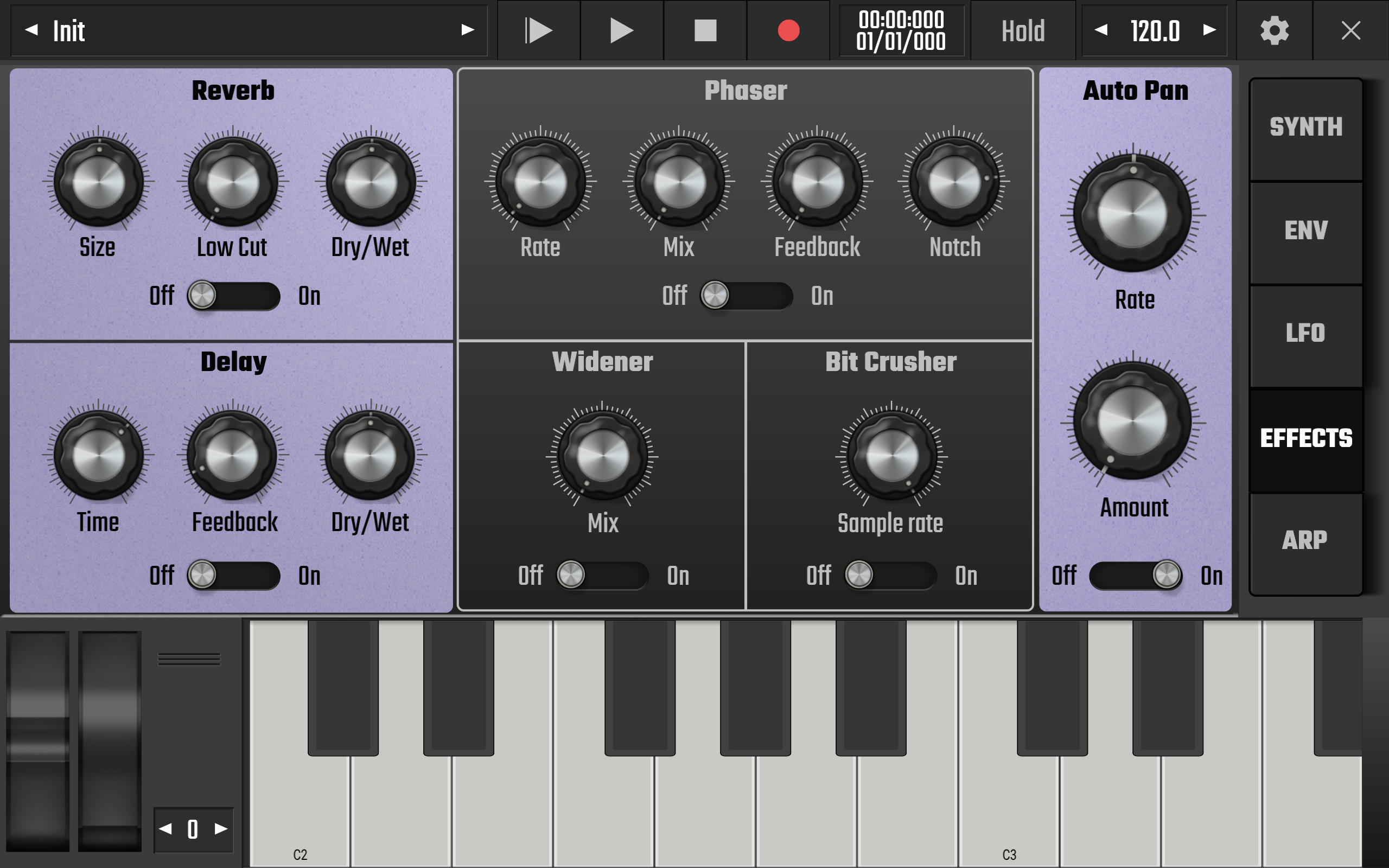
The Evolution One Effects Page offers you six high quality effects which can be creatively applied to your sound within the synth itself. Don't forget, you can also apply any of Audio Evolution Mobile's other effects outside the synth screen by accessing the FX Grid from the synth track channel on the Arranger Page.
Use these quick links to jump to a section.
Reverb
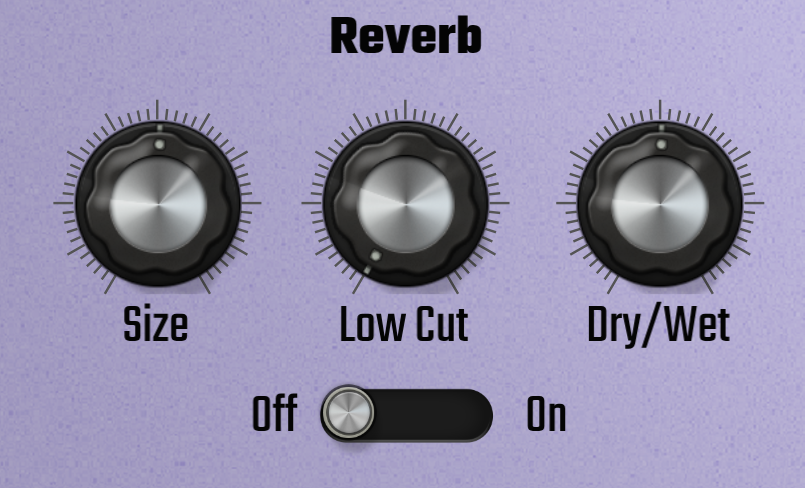
As sound waves travel out from their source they can reverberate, or bounce, off the surfaces of enclosed spaces. This causes us to hear the sound more than once - the original sound from the source and then the attenuated (lower volume) reverberations bounced off the surfaces. The bigger the size of the space, the longer it takes us to hear the reflected reverberations (the greater the delay time) until, if the space is large enough, we perceive them as an echo. Reverb effects recreate this natural phenomenon and allow you to have your sound exist in a defined imaginary space.
Use the On/Off switch to switch the Reverb on and off. The processing involved in high quality reverbs like this can be CPU hungry. If your device struggles to cope you may have to consider keeping the reverb effect turned off.
The Size dial controls the size of the imaginary space your sound exists in, with longer reverberations as the size increases.
The Low Cut dial controls the amount of lower frequencies cut from the reverberated sound. Lower frequency reverberations can have a longer decay (fade away to silence) time than higher frequencies. In practice, this can result in a muddy sounding reverb. Cutting those low frequencies away can give a clearer reverb when required.
NOTE. You may have noticed that 'decay' was mentioned there and be slightly confused after reading about the decay phase of an ADSR envelope. In an ADSR envelope Decay defines the time it takes for the maximum signal level to decrease to the Sustain level but when talking about sound more generally, decay refers to the amount of time it takes for a sound to fade away to silence.
The Dry/Wet dial controls the ratio of 'dry' signal (with no reverb effect) to 'wet' signal (with reverb). It defines the amount of the Reverb effect heard. If this dial is all the way to the left, only the dry signal will be heard. If it is all the way to the right, only the wet signal with the effect applied will be heard.
Delay
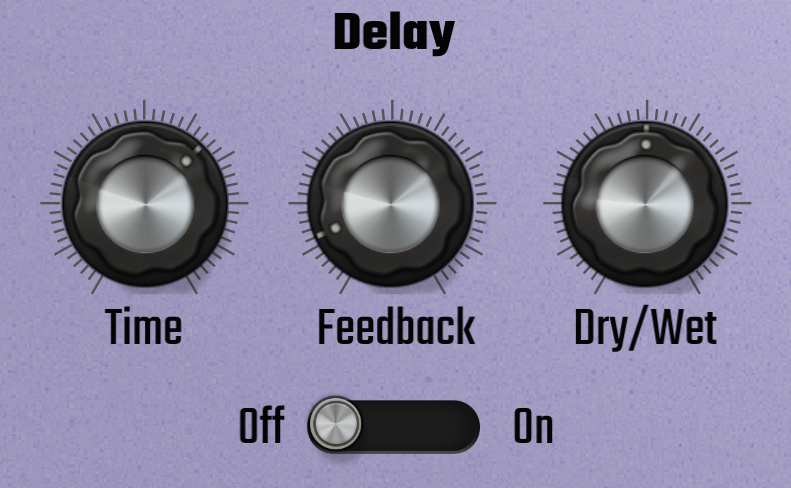
Delay effects record the incoming sound and replay it after a time delay. Depending on the feedback time specified, the sound continues to be delayed and replayed, each time getting quieter until silence is reached. They can be used to create echo effects but they don't really simulate natural phenomenons in the way that reverbs do (though reverbs are delay based effects). They are very creative tools and widely used, in their various forms, within music production and sound design.
The Delay in Evolution One is a 'Ping-Pong' delay meaning that each replaying of the sound alternates from left to right in the stereo sound field or panorama.
Use the On/Off switch to switch the Delay on and off.
The Time dial sets the delay time before the sound is replayed. The increments used by this dial differ depending on whether you have Tempo sync activated or not in the synth Tempo Settings. If tempo sync is active, the time options are musical divisions of the current tempo, from a 1/64th triplet on the left to 2 bars on the right. These divisions are shown in the Playback Timer display as the Time dial is moved. If tempo sync is inactive, the Time dial allows you to freely set the delay time independent of the current tempo.
The Feedback dial controls the amount of time the output is fed back into the input, therefore controlling how long the delay and playback loop will continue until it fades to silence.
The Dry/Wet dial sets the ratio of 'dry' signal (with no Delay effect) to 'wet' signal (with Delay). It defines the amount of the Delay effect heard. If this dial is all the way to the left, only the dry signal will be heard. If it is all the way to the right, only the wet signal with the effect applied will be heard.
Phaser
If two identical sound waves/signals are played from exactly the same point at the same time, the two waveforms will be completely superimposed on top of each other resulting in a summed (the quantity obtained by addition) version of the sound which is double the volume. Superimposed waveforms like this are said to be 'in phase'.
If one of the identical signals is offset (moved), the two signals no longer sit perfectly on top of each other and are said to be 'out of phase'. The phase shift of the second signal causes cancellation of some frequencies and summing of others. Indeed, just as the two in phase signals double the volume, two signals which are completely out of phase at 180° (phase shift is measured in degrees) will cancel each other out completely.
A Phaser creates a copy of the input signal which is fed through a filtering effect where a series of notches, or indentations, in the frequency range cause frequency cuts. These notches are modulated (moved back and forth over time) by a Low Frequency Oscillator (LFO). Finally, this modulated signal is mixed back with the original signal resulting in a constantly moving cancellation and summing of certain parts of the combined signal as the frequencies become more or less in phase. This creates its distinctive sweeping sound.
The On/Off switch turns the Phaser effect on and off.
The Rate dial controls the speed of the Phaser's internal LFO which modulates the notches in the frequency range. This LFO cannot be Tempo synced.
The Mix dial controls the ratio of original signal and modulated signal in the Phaser output. With the dial all the way on the left, only the original signal is heard.
The Feedback dial determines how much of the output signal is fed back into the input to intensify the phasing effect.
The Notch dial controls the width of the spread of notches in the frequency range used by the filtering effect. The closer the notches are, the more pronounced the effect will be. The further the dial is moved to the right the wider the spread of the notches.
Widener
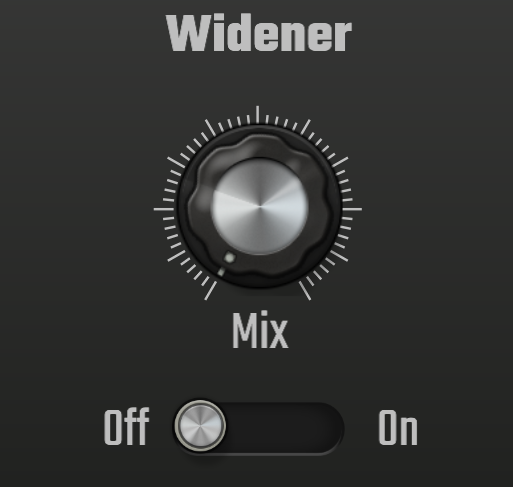
As explained in the Auto Pan section below, the Evolution One synth sound exists in a stereo sound field. The Widener is a clever effect which spreads and widens the stereo effect of the selected preset.
Use the On/Off switch to turn the effect on and off.
The Mix dial controls the amount of stereo widening applied to the synth sound.
Bit Crusher
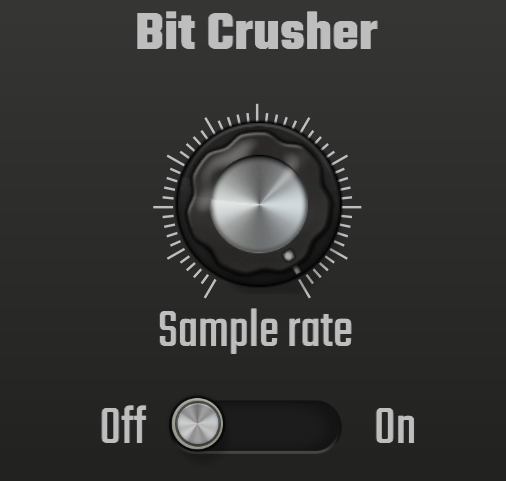
All digital audio is defined by samples, or snapshots, of information (data) which are used to capture, describe and reproduce the equivalent analog sound. The speed at which these samples are captured and played back is called the sample rate. Each sample contains bits (binary digits - 1 or 0) which are used to describe the individual samples.The number of bits used per sample is known as the bit depth. The greater the number of bits used to describe each sample and the greater the number of samples per second, the greater the precision and fidelity to the analog sound achievable. So, all digital audio has a sample rate and a bit depth. For example, digital audio using a sample rate of 44.1 kHz with a bit depth of 16-bit, uses 44,100 samples per second and each sample is made up of 16 bits (i.e. each sample is a string of 16 ones and zeros).
As digital technology has progressed greater sample rates and higher bit depths have become possible (though it is debatable how much of that extra precision is actually perceivable by the human ear beyond a certain point). Back in the earlier days of digital audio though, such things simply weren't possible and lower sample rates and bit depths had to be used. This low sample rate and bit depth, found in early 8-bit samplers and drum machines which typically used sample rates of 28kHz or less, resulted in a 'low-fi' or crunchy sound. This gave such instruments their very own character and appeal, especially in retrospect.
Bit Crushers like this allow you to give your sounds some of this lo-fi digital crunchiness or, indeed, completely crush the sound!
Use the On/Off switch to turn the Bit Crusher on and off.
The Sample Rate dial allows you to artificially lower the sample rate from 48kHz on the right all the way down to 2.048kHz on the left.
Auto Pan
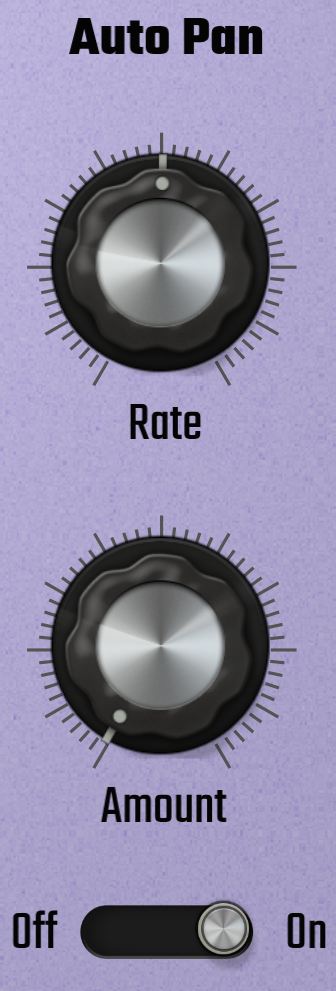
The Evolution One synth sound exists within a stereo sound field. Indeed, the synth Mono mode which can be selected on the Synth Page, simply switches the synth from polyphonic mode, where a maximum of six notes can be played at the same time, to monophonic mode, where only one note can be played at a time; the sound outputted from the synth is always a stereo signal regardless of the mode selected. The full scope of the left to right sound field is called the panorama, usually just referred to as Pan. Panning controls allow you to position your sound within the stereo sound field.
Evolution One's Auto Pan effect automatically moves your sound back and forth across the sound field between left and right.
The On/Off switch is used to switch the effect on and off.
The Rate dial controls the speed at which the sound is moved back and forth. Once again, this is dependent on whether you have Tempo sync activated in the synth Tempo Settings. If Tempo sync is active, the Rate options are hard-linked to various divisions of the current tempo, from 8 bars on the left to 1/64 triplet beat on the right. As with all of the synth controls, these options are displayed in the Playback Timer as the dial is moved. If Tempo sync is deselected, the Rate of the Auto Pan can be set freely, independent of the current tempo.
